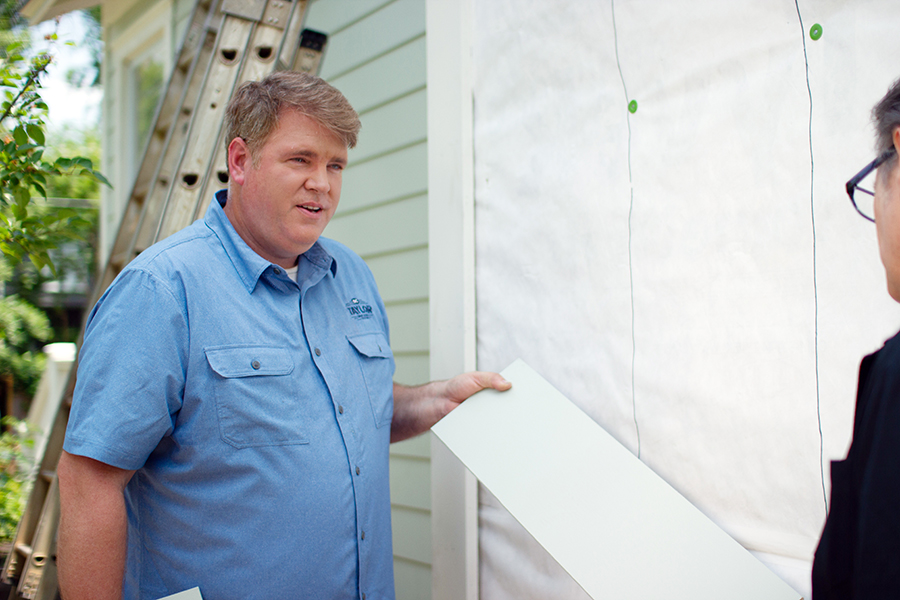Business Advice6 min
Top 3 Different Types of Clients in Construction
As you meet with clients, you may have noticed that their concerns and priorities vary widely. As you know, each client requires a unique approach in order to create the rapport you need for a successful project.
For insight on navigating client concerns and relationships, we called on Brad Leavitt, President at AFT Construction, for his perspective on how to deal with different customers in construction that lead to strong end results. First, let’s look at a few types of clients you’re most likely to see.
What Are the Types of Clients in the Construction Industry?
While your clients will bring a wide variety of concerns, questions and priorities to the table, there are a few considerations that come up most often.
The Budget-Conscious Client
Pricing is a priority for most clients you’ll partner with. You will have to navigate both hard limits on budgets and some that are more flexible. “Pricing is escalating so quickly that customers are concerned that the cost of the home will either exceed their budget or be more than they are willing to spend,” Leavitt adds. “The most challenging part of this process is that homes are typically over a year in design—and then take over a year to build. A two-year process is tough to pin down and control pricing.” For these clients, establish expectations upfront and maintain clear communication about cost as often as possible.
The Schedule-Focused Client
Construction projects are often lengthy, making scheduling and planning a difficult task that may preoccupy some clients. “Schedule is a major factor,” says Leavitt. “With supply chain and labor constraints, homes are taking longer to build. It makes it really difficult for clients to plan. They are concerned that some build times may exceed their construction loan windows.” Talk about how you anticipate the build unfolding from the start and cover any concerns that will be out of your control, such as supply chain issues. With expectations established, clients can adapt and work with you to achieve their goals.
The Sustainability-Minded Client
Homeowners often desire to make sustainable choices in as many aspects of their lives as possible, and you may see clients who are primarily concerned with the health and sustainability of their homes. While this can sometimes be at odds with budget, “clients want homes that are sustainable and healthy,” Leavitt confirms. “They are now really looking at the construction quality and building science. They want to know that their investment is protected.” Be sure to discuss how the materials your clients choose can pay off in the long run—both for them and for the environment.
How to Build an Ideal Customer Profile
A customer profile, or customer persona, is simply a description of one type of client you may encounter. Constructing these profiles is important—tailoring your approach to a client’s specific concerns will help you make stronger connections and solve their concerns more effectively.

You will likely have a variety of customer profiles in mind as you grow your business, but Leavitt advises remembering that all can contain similarities that align with your core values: “I tell all my clients the same thing: I don’t care what your budget or size of home is, I just want to work with good people.”
In that sense, your ideal customer is a great partner who works with you to bring a shared vision to life. “It is a partnership—or short-term ‘marriage’—for two years,” Leavitt adds. “We want to make sure all expectations are clear and set so that it can be the best experience possible.”
To build your ideal customer persona, list a few qualities that make an excellent partner. To get more specific try breaking out different concerns, similar to the top three mentioned above. You may have concerns that are specific to your area of the country or types of projects you see most often. Include unique considerations for each one along with strategies that will help you create rapport with each type of client. With this information noted, you can return to it for reference as you build your business.
Questions a Builder Should Ask a Client
When it comes to your discussions with your clients, focusing on expectations is key. Frame your questions around what your clients have in mind for every step of the build—from design and product selection to the actual jobsite—so that you can get on the same page.
Leavitt sees roadblocks occasionally with setting pricing expectations. “Social media has given them many design and inspirational ideas, but they don’t realize how much all of them can cost. Putting together their appetite with the correct budget is still a struggle.” These experiences highlight the importance of getting on the same page early on in the process with your clients.

When it comes to how to handle an indecisive customer, Leavitt shares his company’s practices: “We always require that our clients hire a designer and select all options and products before we start construction. This really helps the process.” In construction, client involvement can be tricky—but asking questions to uncover your client’s expectations can set the stage for a successful project.
Advice From the Expert
Leavitt recommends, ultimately, to be a thought leader in your industry in order to build trust with your clients. “Take every opportunity to speak on your platforms about the state of the industry,” he says. “I speak about it constantly on YouTube, my podcast and social media. We do all we can to educate them not only on pricing but also building science and new technology, so they are not surprised when we meet.”
Ready to learn more? Read more about building trust with your clients here.
Continue Reading
Resiliency Solutions
5 minIntroducing LP® SmartSide® ExpertFinish® Naturals Collection™: Nature-Inspired Beauty Meets Engineered Performance
We’re excited to introduce the LP® SmartSide® ExpertFinish® Naturals Collection™, a bold new addition to our trusted line of engineered wood siding and trim that delivers the warmth and beauty of nature with the advanced protection and performance builders and homeowners expect.
Labor Solutions
5 minChoosing the Right LP® Structural Solutions Product for Your Build
When it comes to building strong, reliable, and high-performing structures, the materials you choose matter. At LP Building Solutions, we understand that every project, whether it’s a single-family home or a multifamily development, requires structural components that meet your needs for strength, durability, and efficiency.
Sustainability Solutions
5 minBuilding a More Sustainable Future with LP Building Solutions
In today’s world, sustainability is no longer just a buzzword, it’s a blueprint for responsible living and smarter building. As the construction industry seeks ways to reduce its environmental footprint, LP Building Solutions is focused on providing innovative building materials for eco-conscious builders to help reshape what it means to build sustainably
News & Stories3 min
History of Partnership with Gary Sinise Foundation
The LP Foundation is a proud partner of the Gary Sinise Foundation, which supports wounded veterans in several ways. You can learn more about the LP Foundation here.